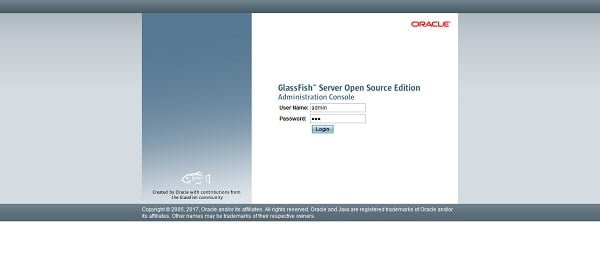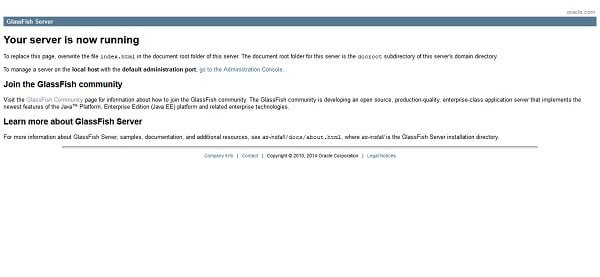In this guide, you will learn, how to install GlassFish on Linux 7 that includes all Redhat based distros. #centlinux #linux #java
Table of Contents
What is GlassFish? :
GlassFish is an open source application server for the Java EE platform. GlassFish project is initially started by Sun Microsystem and now sponsored by Oracle Corporation. GlassFish is free software and dual-licensed under two free software licenses CDDL (Common Development and Distribution License) and GPL (GNU General Public License).
Oracle GlassFish Server was the commercially supported. In Nov-2013, Oracle discontinued support of Oracle GlassFish Server while continuing open source updates. Thereafter, Oracle encouraged its customer to migrate to another alternate product Oracle Weblogic Server.
The only commercially supported fork of GlassFish available is Payara Server.
In this article, we will install GlassFish on Linux 7. We are using the open source version of GlassFish with Oracle Java SE 8.
You should have a reference book like GlassFish Administration (PAID LINK) by Packt Publishing to help you during your GlassFish study.
System Specification:
We are using a CentOS 7 virtual machine with following specification.
- Hostname – glassfish-01.example.com
- IP Address – 192.168.116.147/24
- Operating System – CentOS 7.6
- GlassFish Version – 5.0
Install Java SE on CentOS 7:
Connect with glassfish-01.example.com using ssh as root user.
As a best practice, we always minimally install our CentOS 7 servers and then install required packages on demand.
We required wget and unzip commands to download and extract software respectively. Therefore, we are installing both of these packages using yum command.
# yum install -y wget unzip
GlassFish 5.0 requires Java JDK 8. Therefore, we are downloading Oracle Java SE 8 from Oracle website.
Although, it is not necessary that, we must use Oracle Java SE 8, instead we can also use OpenJDK as well. Since we are using OpenJDK in our previous articles, therefore, we decided to try Oracle Java SE 8 this time.
# wget --no-cookies --no-check-certificate --header "Cookie: oraclelicense=accept-securebackup-cookie" "https://download.oracle.com/otn-pub/java/jdk/8u201-b09/42970487e3af4f5aa5bca3f542482c60/jdk-8u201-linux-x64.rpm" --2019-03-15 00:20:18-- https://download.oracle.com/otn-pub/java/jdk/8u201-b09/42970487e3af4f5aa5bca3f542482c60/jdk-8u201-linux-x64.rpm?AuthParam=1552591337_33165c6d74a8540150b0c2ddb6f3633b Connecting to download.oracle.com (download.oracle.com)|23.198.73.122|:443... connected. HTTP request sent, awaiting response... 200 OK Length: 176209195 (168M) [application/x-redhat-package-manager] Saving to: âjdk-8u201-linux-x64.rpm.1â 100%[======================================>] 176,209,195 152KB/s in 16m 10s 2019-03-15 00:36:29 (177 KB/s) - âjdk-8u201-linux-x64.rpm.1â saved [176209195/176209195]
Install Java JDK 8u201 using yum command.
# yum install -y jdk-8u201-linux-x64.rpm
Loaded plugins: fastestmirror
Examining jdk-8u201-linux-x64.rpm: 2000:jdk1.8-1.8.0_201-fcs.x86_64
Marking jdk-8u201-linux-x64.rpm to be installed
Resolving Dependencies
--> Running transaction check
---> Package jdk1.8.x86_64 2000:1.8.0_201-fcs will be installed
--> Finished Dependency Resolution
Dependencies Resolved
================================================================================
Package Arch Version Repository Size
================================================================================
Installing:
jdk1.8 x86_64 2000:1.8.0_201-fcs /jdk-8u201-linux-x64 288 M
Transaction Summary
================================================================================
Install 1 Package
Total size: 288 M
Installed size: 288 M
Downloading packages:
Running transaction check
Running transaction test
Transaction test succeeded
Running transaction
Installing : 2000:jdk1.8-1.8.0_201-fcs.x86_64 1/1
Unpacking JAR files...
tools.jar...
plugin.jar...
javaws.jar...
deploy.jar...
rt.jar...
jsse.jar...
charsets.jar...
localedata.jar...
Verifying : 2000:jdk1.8-1.8.0_201-fcs.x86_64 1/1
Installed:
jdk1.8.x86_64 2000:1.8.0_201-fcs
Complete!Set JAVA_HOME environment variable.
# echo "export JAVA_HOME=/usr/java/jdk1.8.0_201-amd64/" >> /etc/profile # . /etc/profile # env | grep JAVA_HOME JAVA_HOME=/usr/java/jdk1.8.0_201-amd64/
Check Java version to verify installation.
# java -version java version "1.8.0_201" Java(TM) SE Runtime Environment (build 1.8.0_201-b09) Java HotSpot(TM) 64-Bit Server VM (build 25.201-b09, mixed mode)
Install Glassfish on Linux 7:
Create a user to own Glassfish software.
# useradd -s /sbin/nologin glassfish
Download Glassfish 5.0 from Glassfish website.
There are two editions of Glassfish are available, Web Profile and Full Platform.
Full Platform is the full fledge Java EE server, with complete Java Platform support. Whereas, Web Profile is the subset of Glassfish Full Platform, provides only commonly used elements.
Here, we will download Glassfish 5.0 Full Platform.
# wget http://download.oracle.com/glassfish/5.0/release/glassfish-5.0.zip --2019-03-15 20:29:04-- https://download.oracle.com/glassfish/5.0/release/glassfish-5.0.zip Connecting to download.oracle.com (download.oracle.com)|23.211.4.135|:443... connected. HTTP request sent, awaiting response... 200 OK Length: 119735241 (114M) [application/zip] Saving to: âglassfish-5.0.zipâ 100%[======================================>] 119,735,241 298KB/s in 9m 3s 2019-03-15 20:38:09 (215 KB/s) - âglassfish-5.0.zipâ saved [119735241/119735241]
Extract glassfish-5.0.zip file.
# unzip -d /opt/ glassfish-5.0.zip
Change ownership of /opt/glassfish5 directory.
# chown -R glassfish:glassfish /opt/glassfish5/
Create a systemd service to autostart Glassfish server.
# vi /usr/lib/systemd/system/glassfish.service
and add following directives therein.
[Unit] Description = GlassFish Server v5.0 After = syslog.target network.target [Service] User = glassfish ExecStart = /usr/bin/java -jar /opt/glassfish5/glassfish/lib/client/appserver-cli.jar start-domain ExecStop = /usr/bin/java -jar /opt/glassfish5/glassfish/lib/client/appserver-cli.jar stop-domain ExecReload = /usr/bin/java -jar /opt/glassfish5/glassfish/lib/client/appserver-cli.jar restart-domain Type = forking [Install] WantedBy = multi-user.target
Start and enable glassfish.service.
# systemctl enable glassfish.service Created symlink from /etc/systemd/system/multi-user.target.wants/glassfish.service to /usr/lib/systemd/system/glassfish.service. # systemctl start glassfish.service
Glassfish uses following Service ports.
4848 – Administration Console
8080 – HTTP Service
8181 – HTTPS Service
Allow Glassfish Service ports in Linux Firewall.
# firewall-cmd --permanent --add-port={4848,8080,8181}/tcp
success
# firewall-cmd --reload
successAdd Glassfish binaries to PATH environment variable.
# sed -i 's/^PATH=*/PATH=/opt/glassfish5/bin:/g' ~/.bash_profile
Set password for Glassfish 5.0 Admin user.
# asadmin --port 4848 change-admin-password Enter admin user name [default: admin]> Enter the admin password> Enter the new admin password> Enter the new admin password again> Command change-admin-password executed successfully.
By default, Glassfish Admin Console is running as a clear text HTTP service. Run following command to enable secure administration console.
# asadmin --host glassfish-01.example.com --port 4848 enable-secure-admin Enter admin user name> admin Enter admin password for user "admin"> You must restart all running servers for the change in secure admin to take effect. Command enable-secure-admin executed successfully.
Restart glassfish.service.
# systemctl restart glassfish.service
After restarting glassfish.service, we are not able to access the Glassfish Admin Console.
Thanks to M.S. Dousti at StackOverflow, we come to know about this bug. It is caused by the use of an older version of Grizzly module. As a workaround, he suggested to upgrade the grizzly-npn-bootstrap.jar to a newer version.
Therefore, we have downloaded and upgraded grizzly-npn-bootstrap.jar as per his advice.
# cd /opt/glassfish5/glassfish/modules/endorsed # mv grizzly-npn-bootstrap.jar grizzly-npn-bootstrap.jar.1 # wget https://search.maven.org/remotecontent?filepath=org/glassfish/grizzly/grizzly-npn-bootstrap/1.9/grizzly-npn-bootstrap-1.9.jar -O grizzly-npn-bootstrap.jar --2019-03-15 23:12:01-- https://search.maven.org/remotecontent?filepath=org/glassfish/grizzly/grizzly-npn-bootstrap/1.9/grizzly-npn-bootstrap-1.9.jar Resolving search.maven.org (search.maven.org)... 54.87.22.154, 54.236.172.66, 52.200.115.228 Connecting to search.maven.org (search.maven.org)|54.87.22.154|:443... connected. HTTP request sent, awaiting response... 200 OK Length: 126502 (124K) [application/java-archive] Saving to: âgrizzly-npn-bootstrap.jarâ 100%[======================================>] 126,502 204KB/s in 0.6s 2019-03-15 23:12:03 (204 KB/s) - âgrizzly-npn-bootstrap.jarâ saved [126502/126502] # chown glassfish:glassfish grizzly-npn-bootstrap.jar
Restart glassfish.service.
# systemctl restart glassfish.service
Browse URL https://glassfish-01.example.com:4848/ from a client’s browser. You have to ignore certificate warning and add exception in your browser.

We have reached at the login page of Glassfish 5.0 Admin Console.

Login as Admin user with password, that we have set in previous steps.

We have successfully login to Glassfish Admin Console.
Now, Browse URLs http://glassfish-01.example.com/ or https://glassfish-01.example.com/ from a client’s browser.
Both URLs will bring you to the same page. The only difference is that, former will serve you a clear text HTTP version, however the later will serve a encrypted HTTPS version of the same webpage.

We have successfully install Glassfish on Linux 7 server.
Conclusion:
In this guide, you have learned, how to install GlassFish on Linux 7.
